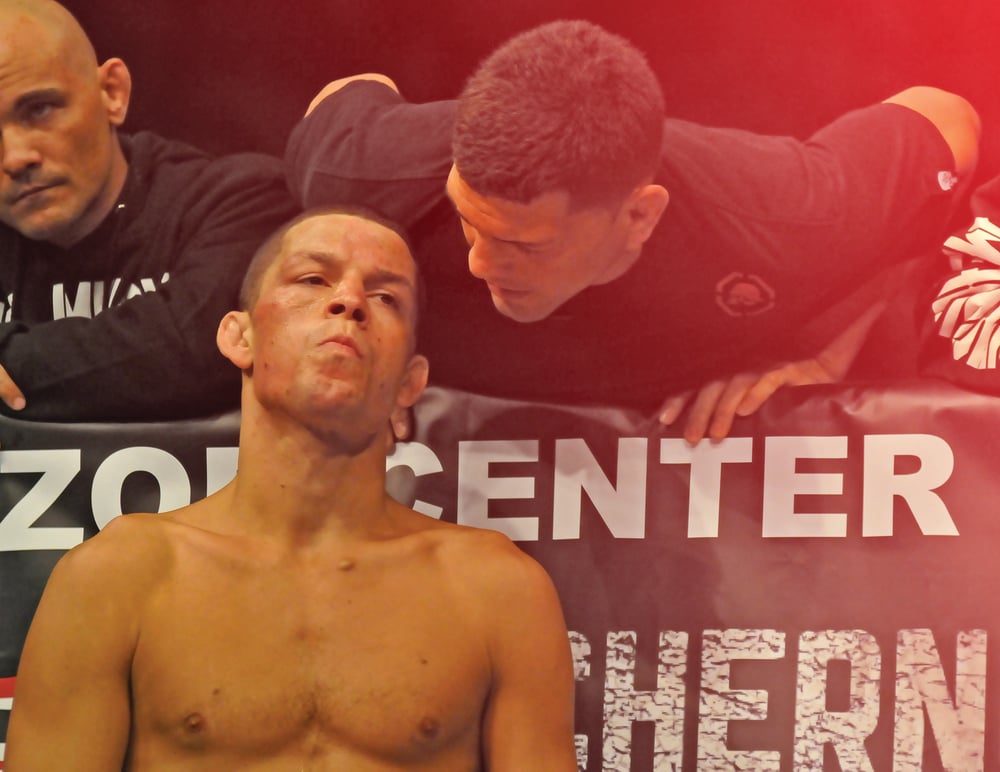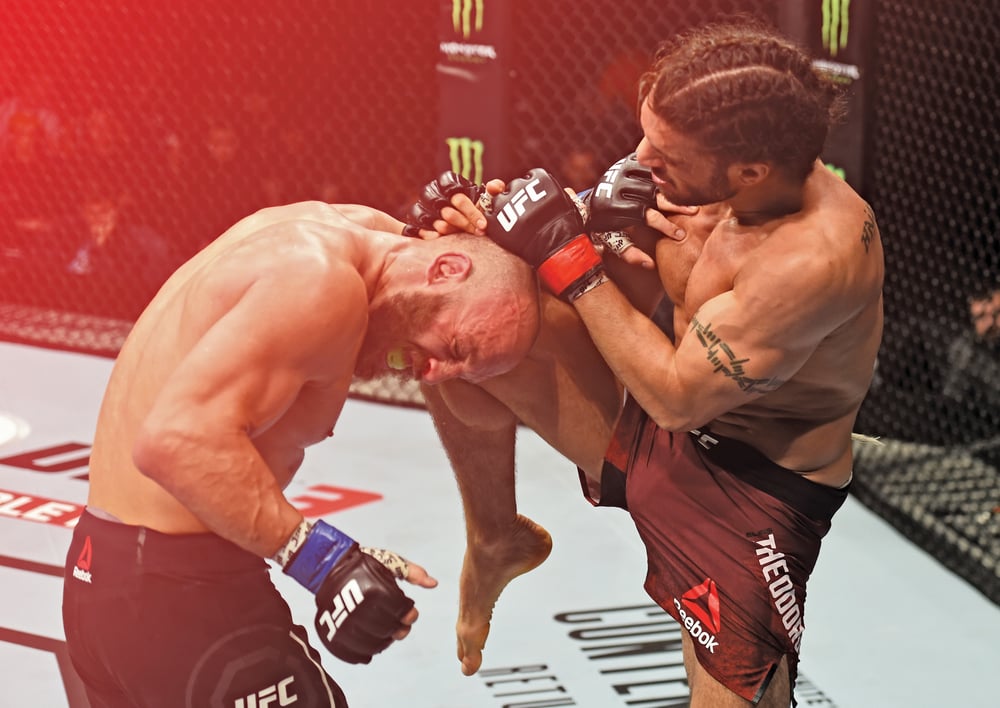
Issue 175
January 2019
Should MMA authorities legalize the use of cannabis? And is its use preferable to traditional painkillers?
It is an open secret that the use of marijuana and cannabis is widespread in mixed martial arts. So open that Nate Diaz vaped at a news conference, Joe Rogan talks openly of its use, and UFC president Dana White once admitted that as many as 80 percent of the competitors on the fight league roster may have used cannabis.
Even Conor McGregor recently applauded Mike Tyson’s recently founded marijuana plantation.
It is certainly becoming less and less notorious. Some fighters use it recreationally, even more for pain relief. But there are growing arguments, and strong views being expressed by many fighters, that the natural drug enhances repair and is better for long-term use than traditional, chemically made painkillers.
We are separating the psychoactive from the medicinal properties of the cannabis plant here. It is a complex subject, this, and one which needs careful treatment and analysis. In the slightly adapted lyrics of the roots reggae musician Peter Tosh: fighters smoke it, judges smoke it, trainers smoke it, even the color commentator, Rogan condones it. It still remains illegal in most territories, and remains on the World Anti-Doping Agency (WADA) banned list. Thereafter, though, threading a route through the subject of cannabis is akin to walking across a mine eld if a fighter does not want to test positive with one, or other, authorities.
The legalization of cannabis in some US States – both medical and recreational cannabis are currently legal in eleven US states – and the same in Canada in October, have heralded a move from many respected voices to attempt to remove a stigma that exists around the concept of ‘weed’, ‘marijuana’, ‘cannabis’, ‘ganja’ or any of the other names which characterize what is seen as a ‘druggie’ lifestyle.

White, president of the UFC, has admitted uneasily that as many as 400 out of 475 fighters on the fight league’s roster may be using cannabis. The drug is still illegal in huge swathes of the world, yet it is a drug that has been employed medicinally for millennia. Some fighters pioneer its use, in defiance of the authorities. The Diaz brothers – Nick and Nate - two UFC stars who are becoming icons for a new “greener” lifestyle; pioneering gluten-free diets, daily jiu-jitsu practice and a medical/recreational use of cannabis that is increasingly typical of many Americans. But the drug, despite being almost commonplace, remains a prohibited substance when it comes to sports, and is still seen by many as taboo. But matters are changing.
For at least two decades it has been used to relieve the suffering of cancer patients, and there are numerous stories of its use down the centuries, as a pain killer and relaxant by any number of warriors, soldiers, traveling armies and fighters of every stripe.
Ever greater numbers of today’s fighters are beginning to make the clear argument that taking cannabis for injuries and as a painkiller during camps, training and after fights, is more effective than over-the-counter or administered painkillers. Last month Kelvin Gastelum told me in an interview for this magazine that he now carefully times his consumption of the drug so as not to find himself punished, as he was when his victory over Vitor Belfort was changed to a ‘No Contest’.

The key question here, as the acceptance of cannabis grows, is whether there is enough medical evidence to clear the slate with WADA. Why is it on WADA’s banned list? Michelle Verroken, the IMMAF’s anti-doping consultant and formerly UK Sport’s leading anti-doping expert, explains: “It is one of the more controversial substances on the list because there is a question raised – always – about whether cannabis has performance-enhancing properties. But the categorizing of prohibited substances comes under three areas, and cannabis fits into two of them as ‘harm to health’ and ‘against the spirit of sport’ category. Given its illegal status then ‘spirit of sport’ would be a very strong reason.”
Perhaps there needs to be a separation, a distinction, between the glorification of the cannabis ‘lifestyle’ to cannabinoid use for medical or therapeutic use.
In August 2016 Nate Diaz lost an exhausting five-round battle with Conor McGregor in Las Vegas, but stole the night’s headlines at the post-fight news conference when he openly vaped. “This is [a vape pen], it’s CBD,” he explained. “It helps with the healing process and inflammation and stu like that. So you want to get these for before, after the fight, training. It’ll make your life a better place.”
CBD – of course – is cannabidiol, a chemical derived from hemp and marijuana, and unlike THC, the plant’s other chemical – which creates a psycho-active high. By vaping, at the time Diaz violated a USADA rule, doing it within four hours after a fight.
USADA changed their rules soon after and removed CBD from the banned list. Many athletes from a wide range of sports are advocating for CBD as a safer and more effective alternative to prescription pills for treating sports injuries.
Many researchers agree. “Certain chemicals within marijuana have anti-inflammatory effects,” says Gregory Gerdeman, a professor of biology at Florida’s Eckerd College. “The most obvious potential benefit to an athlete is controlling inflammation and some of the aches and pains that relate to injury. If you lower inflammation, you will raise the pain threshold.”
There are voices within the sport who want to go further and support a change in cannabis use as a whole. Yet there is a stigma around cannabis, and there may indeed be a danger in glorifying its use. Therefore, it needs genuine supervision. It needs to be distinguished from it being part of a culture, part of a lifestyle.
USADA’s take echoes Verroken’s rationalization of the WADA stance. They say: “Cannabis use can alter the perception of risk, thus potentially leading to poor decision making. It may also impair essential technical skills of the athlete, thus leading to a higher probability of accidents and injuries. Cannabis use may also negatively influence coordination, movement, and time estimation. All these effects may pose a risk for the athlete and others...”
Yet it’s important to note that USADA do not count cannabis as a banned substance in out-of-competition testing.
Michelle Ingels – one of the leading medical advisers on nutrition in combat sports today, and the director of Perfecting Athletes – believes a change should be made and supports its use over painkillers.
The Florida-based medical expert works with Tony Ferguson, Stephen Thompson, Daniel Straus and leading boxers such as Terence Crawford. She is a strong advocate for its use.
“My view is that I absolutely agree with it,” she states, “and I think medically most athletes would benefit from it. It has very few side effects and is an incredible benefit for pain relief, relaxation and focus. The athletes deal very, very well using it, versus pain medication where they may not know how they feel on it.
“It stops the pain but it gives them an upset stomach or nausea, or creates other problems,” she continues. So yes, I absolutely agree with it. The only hesitation I had with medical marijuana is the same with everything else – overuse or abuse. But that’s true of literally anything out there. Literally any other over-the-counter drug is at risk for those two things. So use it conservatively and wisely.”

A doctor who works in the MMA industry – who preferred to remain anonymous – agrees that there are long-lasting negative effects from painkillers. “Absolutely, there are. If you look at ten different painkillers, even something as simple as over-the-counter Adderall, they go through the liver and can create a little congestion and that can lead to liver problems. You can see on the packets it says do not use if you have liver disease.”
“They (traditional painkillers) also have a tremendous ability to create digestive issues. If you take too many of them too often you can get ulcers or inflammation, and it can cause tract bleeding. All of those things affect how you absorb nutrients and absorbing nutrients affects how you make weight and recover. The worse you absorb, the worse you can cut weight and recover so the more you need pain relief.”
Ingels concurs. “What happens is the fighter gets into this (vicious) circle. Anything you can do that doesn’t have these side effects but gives you the pain relief benefit, I’m all for it. And honestly, if you look at hemp oil and seeds, they’ve been used in Chinese medicine for 5000 years. Not only do they stop pain, but they improve your digestion and absorption. There’s way more benefits than negatives.”
What seems clear, however, is that cannabis carries a stigma. “I think everybody is so worried about demonizing it. It’s this terrible thing that you’ll get addicted to and it will lead you to harder drugs,” adds Ingels. “But the truth of the matter is when you get into the studies, research, history of it and look at the people who are using it, it is just the opposite. People will use this instead of getting into hardcore drugs or smoking or alcohol. Let’s be honest it’s not any worse than alcohol or cigarettes and both of those are legal.”
It is, of course, still on the WADA banned list, and may need a campaign for its removal. “In my personal opinion, yes, there should be a campaign. In my professional opinion, yes again,” continues Ingels. “We have absolutely no issue with a professional athlete using it for medical purposes. It can be supervised however they want to do it. But I would absolutely want to see it removed, I would 100 percent back that.”
Verroken, the IMMAF’s Anti- Doping consultant, currently working closely with the sport to create a blanket clean-up, believes clinical trials could bring the issue into focus within WADA’s governing committees.
Until there is a revision, she insists, nothing can be done which will stop athletes from being punished. “We’ve got to make sure that the rules are fairly applied. The process would be that any proposal for change would go to WADA’s ‘prohibitive list committee’ first.
“At the moment the threshold for the level of evidence isn’t quite significant,” she continues. “I don’t think we’ve got enough evidence currently in clinical trials. Because it is the clinical use that is going to make that change possible.”
She agrees, moreover, that there may be a stigma attached. “That may very well be the case given it has legal status in many parts of the world. Any use would have to be considered as part of the controlled drugs legislation. If the law changes regarding its status then perhaps (it will be allowed as a painkiller for fighters). But whilst it’s considered a controlled drug in parts of the world, no.”
That’s something that will be upheld by the International Mixed Martial Arts Federation. Its CEO Densign White said: “IMMAF is compliant with the WADA code and so long as cannabis is on the banned list then it is not permissible under IMMAF rules. It cannot be taken by athletes unless there is no medical alternative to a specific condition. In such a case, the athlete would need to apply for a TUE.”

In mid-October 2018, Canadian mixed martial artist Elias Theodorou did exactly that, stating that he had started his biggest fight: to gain a TUE for medical marijuana/ cannabis. It coincided with nationwide legalization in Canada. In an open letter to the fight authorities and USADA, he wrote: “I am writing this letter in hopes of bringing this subject out of the shadows, to shed light upon (an) unwarranted stigma surrounding medical cannabis, which must be challenged and changed. Therefore, my biggest fight is not against the man standing across from me in the Octagon, but rather against the current stigma associated with medical cannabis, and my right as a Canadian to medically employ it. As I once again get ready to resubmit my TUE application to USADA, from this day forward, Wednesday, October 17th, this is a fight that transcends myself and sport, but one I am determined to win.”
One suspects more fighters will follow that move, but how do the commissions regard marijuana/ cannabis used for pain relief in place of painkillers. Is it changing? Mike Mazzulli, president of the Association of Boxing Commissions and combative sports in the USA, a powerful body in fight sports, acknowledges it’s up for debate. “As president of the ABC, we’re always evolving for the best interests of the support,” he says. “I remember many years ago fining Carlos Newton $5000 for a positive marijuana test. Nowadays, if it’s ‘out of competition’ I wouldn’t fine him because he lives in California and has a medical marijuana card.
“So my rule is ‘out of competition I do not hold you accountable for it’,” he continues. “But if it’s on the day of a fight and is more than 50 nanograms of cannabis or THC, I have a problem with that. With this subject, we’ve got different doctors out there looking at different methods of pain relief. And fighters have told me about this as pain relief. In fact a buddy of mine, his dog is on it for pain relief in his hip. It’s interesting. Absolutely, we need to look at it to get the best for our fighters. You’re talking about it in pill form, so you don’t get the high, you just get the effect of pain relief.”
Ingels again. “We need education here. What we have to put across is that it is not any more performance-enhancing than any other thing. Protein gives you energy and will be performance-enhancing. If it helps you stop pain then it’s performance-enhancing, so does turmeric do that? So do essential fatty acids, so I don’t think it is in the same class as drugs. It’s not a synthetic performance-enhancing drug. It’s more the class of natural food substance.”
So is the growing Stateside legalization a good sign? “I would hope so,” responds Ingels. “There are as many people who oppose it as want it. The interesting thing is if you look at the people that are pro, they’re the ones in the industry who use it and understand it. The people who oppose it are basically going on hearsay and half-truths and aren’t using it themselves, but they’re still very, very powerful people.”
Commissioner Mazzulli again. “It’s interesting because every commission is different in the country in the United States and we all have different guidelines and regulations. For example ‘out of competition testing’ for marijuana, I don’t hold it as problematic, but I do for on ‘fight day testing’ for marijuana. The reason is because it is a depressor that will slow your reaction time. But it’s a real touchy subject at this point. I don’t think we’ve really approached it fully yet.”
Another source – a very senior former state regulator in fight sports who wished to remain anonymous– told me: “I believe the day will come when cannabis is no longer banned for fighters. It’s still illegal federally, remember, if not under individual state law. Several States have now made it legal, but only 50 nanograms. Any more than that, you have a positive test. Some states, such as Wisconsin, have zero tolerance for weed. In my view, this will change (and fighters will be exempt), but not for a while...”
It may a while then until reggae legend Tosh’s lyrics, “Legalise it... don’t you criticize it...” becomes the norm. “It looks like it’s going to be a long-term battle but many of us in the fight sports industry will support it being legalized (for athletes),” Ingels says. “If it needs to be managed closely, it can be managed. But honestly, there are so many worse things out on the market. There are so many worse things out there for your health than using a little bit of cannabis for pain relief.”
...









